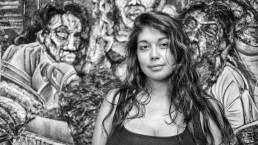
As we approach the last room of her solo exhibition Spirits of the Soil at Amsterdam’s Stedelijk Museum, Raquel van Haver invites me to stay while she meets the museum’s art restorer. They need to fix up one of the paintings, the top of which is every so slightly bending downwards – a common hazard of working with many heavy materials. ‘I was scared the hair on this painting would fall off!’ Raquel laughs, ‘but pretty much everything holds up well.’
Raquel climbs the ladder in her knee-high, high-heeled grey suede boots, fixing the top of the painting herself without a moment’s hesitation. ‘Staat ‘ie recht?’ she asks. (Is it straight?) ‘Rechter!’ the others answer. (Straighter than before!)
I was fortunate to be able to catch Raquel for a chat and a walk through her exhibition, right when I arrive in Amsterdam and just before she takes off to South Africa. Raquel and I met almost ten years ago at Cinnamon Wednesdays, a monthly cultural event in Amsterdam organised by mutual friends which fused music, spoken word poetry, visual arts and community-based awareness in an open, inclusive atmosphere. Today, the 30-year-old artist, who was born in Colombia and grew up in the Netherlands, is continuing with her own fusion of art and community activism, wielding a paintbrush and travelling around the world. She’s travelled from Amsterdam Southeast where she lives and works to countries including Colombia, Nigeria, Trinidad and Tobago and Curacao, meeting and depicting people from all walks of life, among whom are people on the fringes of society who tend to be ignored, avoided, stigmatised or even feared. She’s spent time in the ‘favelas’ of South America and established friendships with the ‘area boys’ in Lagos, loosely organised gangs of teenagers and street children who have set up their own systems in the different neighbourhoods in too-big-too-fast Lagos. In 2018, Raquel won the ‘Koninklijke Prijs voor de Vrije Schilderkunst,’ the prestigious Dutch Royal Award for Modern Painting, and her first solo-show at the Stedelijk Museum Amsterdam opened to great acclaim in November 2018.
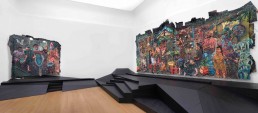
Shira Wolfe – For Spirits of the Soil, you did research in Lagos, Nigeria, but also in other countries. I’m curious to hear about how you choose the places where you go to do artistic research.
Raquel van Haver – Initially, Lagos was related to a different project and it ended up becoming a part of Spirits of the Soil too. Most of the time, institutions, museums or foundations that are supporting me or are commissioning work ask me where I want to go. I usually already have a pretty good idea of where I’d like to go. As it stands, I’ll be working in Colombia, Venezuela and Curacao this year. The Mondriaan Foundation gave me a scholarship to teach at the IBB (Instituto Buena Bista) in Curacao, so I’ll combine that experience with other projects. As you can see, I often combine work trips, or sometimes I return to places where I’ve already been and look back through my photo archives of the place. My main goal is always to take a lot of pictures or film footage when I go somewhere, in order to source information from it.
SW – So how did the research process for Spirits of the Soil go?
RvH – There are 9 prints of collages in the first room of the exhibition, following from my photography project about Lagos which I made during a residency at the African Artist Foundation. I spent a month and a half there the first time I went, and returned several times to take new photographs, make a magazine documenting the process, and show my work during Lagos Photo Festival. When I first arrived I remember thinking: ‘There’s no way I can do this!’ I mean, I’m not a photographer, I’m a painter. But in the end I started researching the city and I collected a huge amount of photographs with which I ended up making the collages. In Lagos, I discovered that throughout the years, I’ve actually been taking the same types of photographs in the same kinds of places all over the world. At one point I arrived at a street party, and I saw all these tables on the street, bottles of beer, food, dancing people, lights. This image was so familiar to me. I had seen and experienced this kind of togetherness in Amsterdam, in London, in Cuba, in Trinidad, in Colombia, you name it. The same setting, the same kinds of people in different groups eating together, it’s just warm and cosy. The other day someone came up to me at my exhibition and said: ‘The only word you can really use to describe your work is “gezelligheid.”’ [‘Gezelligheid’ is an almost impossible to translate Dutch word that loosely means cosiness, warmth, fun and hominess all in one.] So I got out all my photographs from my archive and started making new compositions.
Spirits of the Soil is really about different groups of people who have been scattered all over the world, due to various factors like the diaspora, colonialism, work, refugee crises, religious persuasions, etc., and about all their similarities. For example, the Coca-Cola crates that you see everywhere that people sit on, the plastic chairs, Heineken beer, the postures, the customs, people’s appearances, the food… I came across all these things in all these different countries, so it’s like a journey, a circle which you’re constantly making. In essence it’s a very simple, beautiful topic. I like for things in my work to come across ‘in your face.’ I want something that everyone here at the Stedelijk can get.
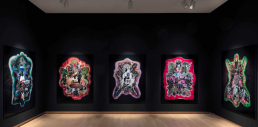
SW – Can you tell me something about your working process? When I see your work I can almost hear spoken word poetry, music, and storytelling. It really jumps out at me from the canvases.
RvH – I have to work with music. I mean I can do it without, but I really prefer not to. It’s like I need to get into a kind of trance. And also, you know this as well, it’s like back in the day at Cinnamon. All these art forms together, these things shape you. I think a lot of experiences here in Amsterdam shaped me, all these spoken word events… And I can see this live on among other people my age, no matter where they are now. Sometimes I also interweave texts throughout my canvases – at times these are song lyrics, at other times they come from books.
I once created new texts by mixing biblical texts about women with really trashy lyrics from Dancehall music, as well as with other sentences about women from ads and books. This led to some really funny stories. I like to play with these things and use things that I hear in my everyday life. This creates a layering: sometimes you don’t even see the texts at first, or you don’t see them at all because they’re buried under layers of paint and materials. If you look carefully, you can see the canvas, the chalk and fragments of texts underneath the thickly layered paint.
SW – It’s funny that you mentioned Cinnamon, because I was thinking about that when I was biking here to meet you. We met there, and that whole scene was about combining different art forms, from visual art to spoken word and music. That definitely leaves its mark, which I somehow recognise in your work.
RvH – Yes, and everyone was so young too, 8 or 10 years ago. If you look at that group of Amsterdam-based activists and artists from back then, we were young, we all had a goal, but most of us were still studying. And in those 10 years, everyone in that group really did achieve something with their work and their activism. It’s not like we were just fooling around. There was already a kind of activism going on back then, the knowledge that things had to change. And it’s a powerful thing that everybody went on to work with this in their own way. I chose to do this by painting. I mean, I was also out there demonstrating like crazy for a while. But I’m good at playing the game in the ‘white cube.’ It’s important that these stories are being told in a museum like the Stedelijk, because you don’t ever get to see or hear them, so this is my demonstration.
SW – Have you had the opportunity to show your work to the people in the countries where you were doing your artist-residencies and artistic research?
RvH – The works in the first space started out as a project for my residency at the African Artist Foundation, so I showed smaller versions of the works there and made a magazine for the people in Lagos. When I do residencies I make drawings and murals, and I leave all of those behind. In terms of the large-scale works, they often go to London where I’m represented by Jack Bell Gallery. It’s too hard to ship them long-distance so I usually end up showing drawings or small paintings, since I can just take the smaller works in my suitcase, and people tend to really like the smaller portraits and drawings.
SW – And how do the people who have inspired your art respond to your work?
RvH – In Lagos, I made that magazine with the photographs I took and I organised a big party as a thank you for the guys that I was spending time with while I was there. I wasn’t able to show the work to everyone, but I did give the magazines to several people. However, I had to be careful in some places too, because art could be seen as witchcraft. Some people couldn’t grasp the fact that an outsider was able to melt into a community like that and make art, which led to this notion of witchcraft. But whenever I would really make a painting about someone, I would always tell them. With the collages, I ended up changing some people’s faces or covering them because they didn’t want to be in the paintings. So it’s about finding the balance between the artistic freedom and the respect that I have for the people, and it can be difficult. But then there are other people who think it’s all really cool. In principle, I try to share as much as possible.
Sometimes, people are really honoured to be portrayed in my work. I once did a series about a group of guys I always saw hanging around on my corner in Amsterdam Southeast. I was super fascinated by what they were doing there. And luckily, since I’ve been living in that neighbourhood for a long time, I knew a few of them so I just started standing next to them with a camera and ended up spending time with them for half a year. It turned out that they all had a dog, these Staffordshire Bull Terriers or something. And then I discovered that they were spending a lot of time in the studio making music. Some of them were unemployed, others had temporary gigs or were still studying, and their sense of community gave them energy to push through. Eventually, I found out they were all breeding dogs to make some extra cash. So these guys were leading a totally different kind of life from most people, and this all became part of the project. I would take pictures of them, and they had a real fascination for the camera. I finally showed these paintings in Amsterdam and in London, where I’d also painted a group of guys. Aside from this I invited a group of men from my neighbourhood to come to my studio, and did their portraits. This resulted in my first big solo exhibition. When I had my exhibition opening I brought most of the guys with me. They were already really honoured that I’d painted them, and then people started recognising their faces from the paintings… So this is when those two worlds collided, worlds which would otherwise never meet. That’s what I’m trying to do with shows, is to bring those two worlds together.
SW – So how does that process go, from the meeting to the story on the canvas?
RvH – First I find a topic that I’m interested in, then I do research. Often, I find a way to research the subject and meet people through friends, and this process can last a couple of months, or even years. The photographs come gradually, I never start with that. First, I just sit down among a group of people and keep coming back. I begin by simply observing, and then I start to take pictures, and often people start approaching me to take selfies until it starts getting bigger and I think it’s becoming interesting. Then I tell people I’m working on something and want to make something. And then I usually hang out with a few people, but often there are still around 30 people hanging around. So this can be difficult too, because how do you deal with that? In general, though, people know that I’m taking pictures and they know if they come and sit next to me, they’ll end up in the photo’s. Sometimes I even create a setting and invite people to come and be photographed. Once all the pictures have been taken, I find the best one and the others go into my archive. Then, I start sketching until I get the composition right, and after that I start transferring the image onto the canvas with chalk.
SW – Can you tell me something about the materials you use in your paintings?
RvH – I stretch the canvases myself with burlap because I work with extremely thick layers of paint. If I were to use normal fabric the paint would just slide off. I tried that a few times, especially in the beginning, but never again! I prepare the canvases with glue, and then with tar because if you prepare it with gesso you’ll close the holes in the burlap. Since I work with a very thick technique, I want to push the paint through the burlap in order to create a kind of carrier of paint on both sides, which makes the canvas sturdier.
After setting up the canvas I start with the drawing. From that moment onwards I work from thick to thin. A thick layer first, then a thin layer. I tend to play a lot with the balance, figuring out where it can be heavy, where it can be lighter, so I’m really occupied with composition and colour when I’m painting. I even totally forget about the image at that point. The social topic of the painting falls away too, and I’m just painting.
SW – And what about the objects you add to the canvases?
RvH – Usually, the objects in my paintings carry a certain symbolic significance. They’re are always added at the end, like the cigarette butts I find in my studio or get from friends after they’ve had a party, or old mobile phones my friends bring me. People always enjoy recognising their things in my paintings. The fake hair I get at the ‘toko’ [small Asian and Caribbean shops in the Netherlands], and in the end I’m always standing there like a hairdresser, cutting hair for my own painting!
SW – Do you feel like your style as an artist has changed a lot through the years, or have you always felt that this is your voice and style?
I graduated from art academy with this kind of large-scale work, and at the time I still thought it was really thick, but now I don’t anymore! There’s really this sense of masculinity in the work, which was always very present. I used to paint more with dark colours, and now it’s become a lot more colourful. Once I started working with oil paint I really started to investigate how far I could take the thickness in the work. I think this is important. I don’t believe that as an artist you should necessarily show your work to the world when you’ve only been doing something for like half a year. For me, a big part of this work is about technique. It’s about figuring out how to manipulate your materials in such a way that it can get really thick and layered and contain the colours.
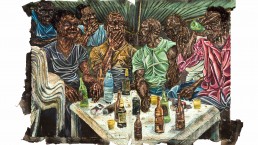
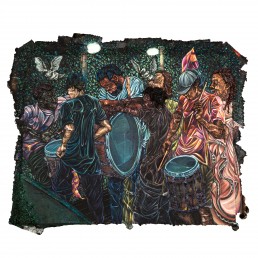
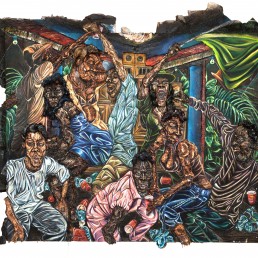
SW – Can you tell me about some artists you have met on your travels and during your artistic research abroad whom you admire and who have inspired you?
RvH – I love Angelica Dass’s work. She’s a Brazilian artist who lives in Spain, and started a project about skin colour. She photographs everybody she knows and finds the corresponding colour to their skin, working with all kinds of little testers and equipment, and this goes into a file. She then makes these large walls filled with colours, and adds the passport pictures in order to show people’s different facial features. It’s really absurd, but super beautiful, and it really gets people thinking about questions surrounding ‘mixed race’ and ‘what you are.’ And people start realising it’s all nonsense because ‘white’ and ‘black’ don’t exist. That’s an incredibly beautiful project which is really inspiring.
Other artists I love are Kudzanai Chiurai from Zimbabwe; Zanele Muholi from South Africa, whose solo show was on at the Stedelijk last year; my friend Rabi Koria, a Syrian artist who lives in Holland and recently had an exhibition at Art Rotterdam; the Belgian photographer Sanne Wilder and her Island of the Colourblind project; Sheena Rose from Barbados; Jamaican artist Ebony G. Patterson; Kemay Wa Lehulere from South Africa; and Igshaan Adams, also from South Africa… I could keep going for hours!
SW – I read this interview with you in which you said that you went to Colombia, the country where you were born, when you were 20 years old and realised there were barely any representations in museums there of people who look like you.
RvH – It was definitely an eye-opener for me to see that there was barely any representation of people of colour in museums in Colombia. Of course I was aware of this already, but it still shocked me. I was especially aware of the fact that this wasn’t really taught at the art academy in Holland, so I thought I’d go to Colombia to learn more about it. When I got there a lot of the topics in museums were about pre-Colombia, and though there was a lot of history it was mostly in the shape of artefacts. But when I went to see the paintings it was all still so white. So I started to think ‘ok, there’s definitely a pattern here and I’m not ok with this.’ In Mexico you had the Mexican muralists, who were making art accessible for the working class, and I started thinking that’s what we should be getting into more. And especially here in the Netherlands, where I grew up after all, I just want to contribute and show my work. Everyone is talking about change but we still don’t see much improvement. So in the end that became my fight, to make change happen in the museums, in the institutions.
SW – Exactly, and in education as well, right? I remember how little we were taught about the Netherlands’ colonial history in high school.
RvH – Yes, you’d get like one sentence on it, if you were lucky. This just has to be different. I was having a drink with a woman who just moved here from Brooklyn, and she was saying how great it is here, how we don’t have any problems. And my friend Raul Balai, who’s an amazing artist and activist, and I looked at each other and started telling her some stories, and her jaw literally dropped. She said she hadn’t seen any of that yet, and we told her: ‘Just wait till you’ve been here for a year.’ People are hiding behind the concept of tolerance and their white innocence in this country. It’s like people communally decided that it’s simply not a problem and that that’s a fact, and you see this everywhere and this needs to change.
SW – What’s next for you? You’re travelling to South Africa in a few days, is that for work or pleasure?
RvH – It’s mostly work-related. I have a lot of new projects coming up and mainly I’ll be meeting artists and colleagues to discuss plans. I’m going to Capetown Art Fair to speak to some cool curators and artists about doing collaborations with them. I’ll also be meeting up with some collectors to see if we can make some new projects happen. At this point it’s still too fragile to talk about but we’re getting ready to do some really cool projects, so there’s more to come!
One thing I’m working on is a collaboration between artists from the Netherlands and artists from Zimbabwe. It’s a project I started in 2016 with the artist Admire Kamudzengerere about folklore and taboos. Last year, we invited a few artists from Zimbabwe to the Netherlands to do the same research on folklore and taboos, only here in the Netherlands. Now, we’d like to bring a few Dutch artists back to Zimbabwe again.
I also have a solo exhibition coming up in July at Jack Bell Gallery in London. The show is about house parties in Amsterdam, which are really universally relatable and which people experience in a similar way all over the world.
So this is an exciting period, where I’m figuring out exactly which projects are going to happen.
Raquel van Haver’s solo exhibition Spirits of the Soil is on view at the Stedelijk Museum Amsterdam through 7 April 2019. Click here to take a look at the exhibition with Raquel herself.
Museum
Stedelijk Museum Amsterdam
Opening year
1895
Opening Times
Daily: 10 am – 6 pm
Friday: 10 am – 10 pm
Address
Museumplein 10
Amsterdam, The Netherlands